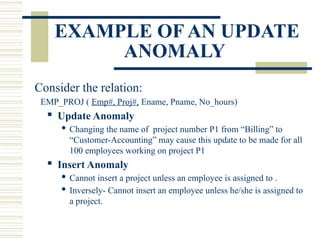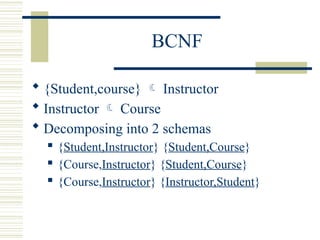Normalization.pptx Functional dependence
- 1. Functional Dependencies and Normalization for Relational Databases Dr. Ali Obaidi CS-450 Fall 2002
- 2. Informal Design Guidelines for Relational Databases Relational database design: The grouping of attributes to form "good" relation schemas Two levels of relation schemas: The logical "user view" level The storage "base relation" level Design is concerned mainly with base relations Criteria for "good" base relations: Discuss informal guidelines for good relational design Discuss formal concepts of functional dependencies and normal forms 1NF 2NF 3NF BCNF
- 3. Semantics of the Relation Attributes Each tuple in a relation should represent one entity or relationship instance Only foreign keys should be used to refer to other entities Entity and relationship attributes should be kept apart as much as possible Design a schema that can be explained easily relation by relation. The semantics of attributes should be easy to interpret.
- 6. Redundant Information in Tuples and Update Anomalies Mixing attributes of multiple entities may cause problems Information is stored redundantly wasting storage Problems with update anomalies: Insertion anomalies Deletion anomalies Modification anomalies
- 9. EXAMPLE OF AN UPDATE ANOMALY Consider the relation: EMP_PROJ ( Emp#, Proj#, Ename, Pname, No_hours) Update Anomaly Changing the name of project number P1 from “Billing” to “Customer-Accounting” may cause this update to be made for all 100 employees working on project P1 Insert Anomaly Cannot insert a project unless an employee is assigned to . Inversely- Cannot insert an employee unless he/she is assigned to a project.
- 10. EXAMPLE OF AN UPDATE ANOMALY (2) Delete Anomaly When a project is deleted, it will result in deleting all the employees who work on that project. Alternately, if an employee is the sole employee on a project, deleting that employee would result in deleting the corresponding project. Design a schema that does not suffer from the insertion, deletion and update anomalies. If there are any present, then note them so that applications can be made to take them into account
- 11. Null Values in Tuples Relations should be designed such that their tuples will have as few NULL values as possible Attributes that are NULL frequently could be placed in separate relations (with the primary key) Reasons for nulls: a. attribute not applicable or invalid b. attribute value unkown (may exist) c. value known to exist, but unavailable
- 12. Spurious Tuples Bad designs for a relational database may result in erroneous results for certain JOIN operations The "lossless join" property is used to guarantee meaningful results for join operations The relations should be designed to satisfy the lossless join condition. No spurious tuples should be generated by doing a natural-join of any relations
- 14. Functional Dependencies Functional dependencies (FDs) are used to specify formal measures of the "goodness" of relational designs FDs and keys are used to define normal forms for relations FDs are constraints that are derived from the meaning and interrelationships of the data attributes
- 15. Functional Dependencies (2) A set of attributes X functionally determines a set of attributes Y if the value of X determines a unique value for Y X Y holds if whenever two tuples have the same value for X, they must have the same value for Y If t1[X]=t2[X], then t1[Y]=t2[Y] in any relation instance r(R) X Y in R specifies a constraint on all relation instances r(R) FDs are derived from the real-world constraints on the attributes
- 16. Examples of FD constraints Social Security Number determines employee name SSN ENAME Project Number determines project name and location PNUMBER {PNAME, PLOCATION} Employee SSN and project number determines the hours per week that the employee works on the project {SSN, PNUMBER} HOURS
- 17. Functional Dependencies (3) An FD is a property of the attributes in the schema R The constraint must hold on every relation instance r(R) If K is a key of R, then K functionally determines all attributes in R (since we never have two distinct tuples with t1[K]=t2[K])
- 18. Inference Rules for FDs Given a set of FDs F, we can infer additional FDs that hold whenever the FDs in F hold Armstrong's inference rules A1. (Reflexive) If Y subset-of X, then X Y A2. (Augmentation) If X Y, then XZ YZ (Notation: XZ stands for X U Z) A3. (Transitive) If X Y and Y Z, then X Z A1, A2, A3 form a sound and complete set of inference rules
- 19. Additional Useful Inference Rules Decomposition If X YZ, then X Y and X Z Union If X Y and X Z, then X YZ Psuedotransitivity If X Y and WY Z, then WX Z Closure of a set F of FDs is the set F+ of all FDs that can be inferred from F
- 20. Introduction to Normalization Normalization: Process of decomposing unsatisfactory "bad" relations by breaking up their attributes into smaller relations Normal form: Condition using keys and FDs of a relation to certify whether a relation schema is in a particular normal form 2NF, 3NF, BCNF based on keys and FDs of a relation schema 4NF based on keys, multi-valued dependencies
- 21. First Normal Form Disallows composite attributes, multivalued attributes, and nested relations; attributes whose values for an individual tuple are non-atomic Considered to be part of the definition of relation
- 24. Second Normal Form Uses the concepts of FDs, primary key Definitions: Prime attribute - attribute that is member of the primary key K Full functional dependency - a FD Y Z where removal of any attribute from Y means the FD does not hold any more
- 25. Examples Second Normal Form {SSN, PNUMBER} HOURS is a full FD since neither SSN HOURS nor PNUMBER HOURS hold {SSN, PNUMBER} ENAME is not a full FD (it is called a partial dependency ) since SSN ENAME also holds A relation schema R is in second normal form (2NF) if every non-prime attribute A in R is fully functionally dependent on the primary key R can be decomposed into 2NF relations via the process of 2NF normalization
- 28. Third Normal Form Definition Transitive functional dependency – if there a set of atribute Z that are neither a primary or candidate key and both X Z and Y Z holds. Examples: SSN DMGRSSN is a transitive FD since SSN DNUMBER and DNUMBER DMGRSSN hold SSN ENAME is non-transitive since there is no set of attributes X where SSN X and X ENAME
- 29. 3rd Normal Form A relation schema R is in third normal form (3NF) if it is in 2NF and no non-prime attribute A in R is transitively dependent on the primary key
- 30. BCNF (Boyce-Codd Normal Form) A relation schema R is in Boyce-Codd Normal Form (BCNF) if whenever an FD X A holds in R, then X is a superkey of R Each normal form is strictly stronger than the previous one: Every 2NF relation is in 1NF Every 3NF relation is in 2NF Every BCNF relation is in 3NF There exist relations that are in 3NF but not in BCNF The goal is to have each relation in BCNF (or 3NF)
- 33. BCNF {Student,course} Instructor Instructor Course Decomposing into 2 schemas {Student,Instructor} {Student,Course} {Course,Instructor} {Student,Course} {Course,Instructor} {Instructor,Student}
- 34. Example Given the relation Book(Book_title, Authorname, Book_type, Listprice, Author_affil, Publisher) The FDs are Book_title Publisher, Book_type Book_type Listprice Authorname Author_affil
- 35. Example What normal form the relation in?














![Functional Dependencies (2)
A set of attributes X functionally determines a set of
attributes Y if the value of X determines a unique value for
Y
X Y holds if whenever two tuples have the same value for
X, they must have the same value for Y
If t1[X]=t2[X], then t1[Y]=t2[Y] in any relation instance r(R)
X Y in R specifies a constraint on all relation instances
r(R)
FDs are derived from the real-world constraints on the
attributes](https://image.slidesharecdn.com/normalization-241010072708-d5114589/85/Normalization-pptx-Functional-dependence-15-320.jpg)

![Functional Dependencies (3)
An FD is a property of the attributes in the
schema R
The constraint must hold on every relation
instance r(R)
If K is a key of R, then K functionally
determines all attributes in R (since we never
have two distinct tuples with t1[K]=t2[K])](https://image.slidesharecdn.com/normalization-241010072708-d5114589/85/Normalization-pptx-Functional-dependence-17-320.jpg)

















